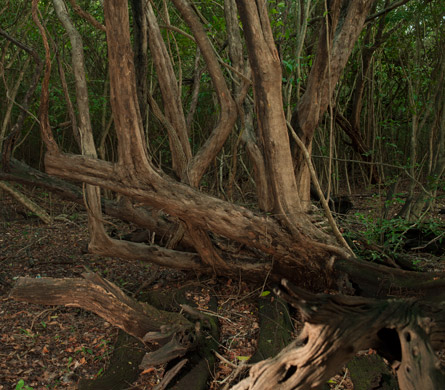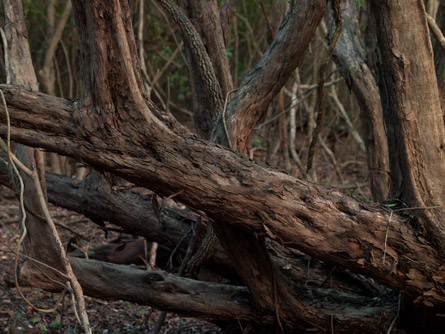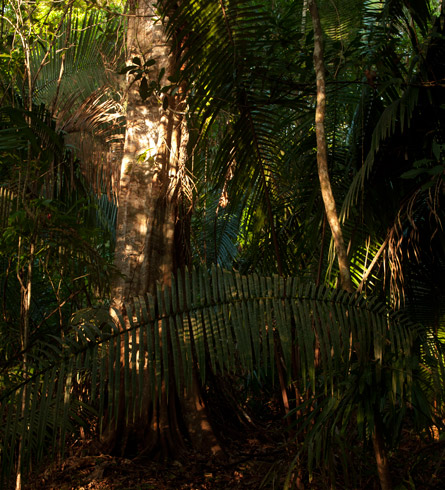Two durable woods were used by the Maya for lintels and vault beams
Wood from two trees were commonly used by the Classic Maya in their architecture:
- sapodilla (Chico zapote, chicle tree, in Tikal Temples I, II, and III) .
- logwood (palo de tinto, also called palo de Campeche, Temple V and Temple VI)
 |
|
Haematoxylum campechianum, palo de Campeche tinto, Guatemala Peten, Belize logwood.
|
You can also find these two species in the palaces of the Central Acropolis. This web page introduces one of these two construction woods, palo de tinto, Haematoxylum campechianum.
Despite the importance of logwood in Maya architecture it is another tree, Manilkara zapota (L.) which is the best known of the hardwoods of Maya architecture. Every tourist to visit Tikal is told about the carved wooden lintels made from "chico zapote." Because chico zapote produces chicle (chewing gum) it is much better known to tourists than logwood.
The Classic Maya used scores of other trees in house construction, as you can see in the book by Lundell (1937), the article by Lundell (1938) or monographs and articles on native Maya houses (Wauchope 1938; Wauchope 1940).
Common names for Haematoxylum campechianum
The names used most frequently in Guatemala are palo de tinto or palo de Campeche. Palo de tinta is also spelled palo de tinte. An area with many of these trees may be called a tintal (tintales plural).
The Latin word is normally spelled Haematoxylon (Wayne). But more than once I have seen it spelled Haematoxylum campechianum).
Bloodwood and logwood are common names in English.
Logwood, palo de tinto (dye wood), Haematoxylum campechianum
Logwood is used in native Maya house construction today, and was used as beams in royal temples and palaces a thousand years ago. I found remains of logwood beams in the corbelled vault of the Tomb of the Jade Jaguar that I unearthed in 1965 under a pyramid facing Temple II on the Great Plaza of Tikal. This burial of the Tepeu 2 ceramic period was constructed sometime between AD 750 and 850.
Even when it has rotted away you can easily tell what is Haematoxylum campechianum because of the shape of the wood. The Maya used Haematoxylum campechianum without changing the original warped shape of the trunk or branches.
Altough the logwood beams in this tomb had rotted (during the more than thousand years since they were put in the royal burial crypt), other logwood beams can still be found intact at Tikal and at a few other Maya sites.
This web page introduces the use of logwood for architectural uses. But the primary use of palo de tinto is to produce colorants, as a dye. Several parts of the tree are also popular as native Maya medicine.
The demand for the dye from logwood is the reason the British took over what is now Belize and colonized it: tons and tons of logwood were needed to dye cotton and wool during the Industrial Revolution in the UK.
Architecture is a major feature of Classic Maya civilization
The Maya are world-renowned for their achievements in astronomy, hieroglyphic writing, sculpture, and architecture. But many scholars estimate that aspects of hieroglyphic writing and sculpture were evolved from the earlier Olmec and definitely from intervening proto-Maya cultures, such as Izapa (Chiapas, Mexico). Although clearly mounds and terraced pyramids were also inherited from earlier civilizations, the specific features of monumental stone architecture of Honduras, Peten, Belize, Chiapas, and the Yucatan peninsula were largely a local development within the Maya areas.
 |
|
Haematoxylum campechianum, palo de Campeche tinto, Guatemala Peten, Belize logwood.
|
Plus the Classic Maya erected pyramids, and temples, which were larger than most Olmec and proto-Maya structures. El Mirador, Tikal, Yaxha, and Nakum are only a few of the examples of monumental Maya structures which continue to attract attention today.
I became interested in the architecture of the Maya at age 16, when I wandered through Mexico (by myself even at this age) and visited Palenque. This trip actually was one factor of getting into Harvard, where (in my junior year), I took a year off and went to Tikal to work as a student assistant for the recording of monumental architecture. I worked on both Early Classic and Late Classic architecture. Then for over 20 years I lectured for tour groups visiting Maya ruins in the Chenes, Puuc, Rio Bec, Belize, Palenque, and Yaxchilan areas. So I have a relatively good first-hand experience with temples, palaces, pyramids, and ball courts of the entire Maya realm, including El Salvador, Belize, Honduras, and of course Mexico and Guatemala.
I have experienced wooden beams from my own field work at Santa Rosa Xtampak, a project of architectural recording of the Chenes-Rio Bec architecture of that remarkable Maya city. There were plenty of wooden beams still perfectly preserved.
I have experienced palo de tinto along the Arroyo Petex Batun and Arroyo Pucte, both tributaries of the Rio de la Pasion, while lecturing for tour groups during the 1970's through 1980's.
Artifacts of logwood
I am not yet familiar with artifacts carved out of logwood, but since this wood lasts a long time such artifacts should be looked for. But considering that several hundred other species of tree wood was available, I would guess the ancient Maya selected other wood for their artifacts. The Maya also made idols out of rubber (the Maya also burned rubber as incense).
Logwood is used in medicine
The bark and other parts of the tree are used to treat many illnesses. Haematoxylum campechianum is even listed in a book on the major medicinal plants of Mexico. (Hernandez and Gally 1981). This book singles out the most commonly used 184 medicinal plants of Mexico. Keep in mind that the total count of medicinal plants of pre-Hispanic Mesoamerica is in the hundreds and hundreds. So if Haematoxylum campechianum is in this book it suggests it was a major source of medicine in Mexico.
Other interesting plants in the same family: List of species of palo de tinto (logwood) in the Mesoamerican area
palo de brasil or palo de tinto (Haematoxylum brasiletto). It has a remarkable distribution from desert hillsides and arroyos of Sonora and Chihuahua, extending south through tropical dry forests of Oaxaca, Guatemala, Costa Rica and Colombia. The heartwood of palo de brasil is equally as valuable as logwood, and has been exported in large quantities from the west coast of Mexico. It has also been used locally as a dye for cottons and wool, and as a pink coloring for various pharmaceuticals including toothpastes and mouthwashes. According to Lillian Diven, writing in Saguaroland Bulletin (1977), palo de brasil was well known to the Aztecs and was also a prominent dye in Maya weaving (Wayne).
 |
|
Haematoxylum campechianum, palo de Campeche tinto, Guatemala Peten, Belize logwood.
|
FLAAR is studying the two species: basically Palo de Brazil grows in dry deserts, both in Mexico and in Guatemala. The hills as you approach the Rio de Motagua desert area are filled with Haematoxylum brasiletto). Indeed along both sides of the Carretera al Atlantico (the main highway from Guatemala City to Puerto Barrios) there are over 25 kilometers where Haematoxylum brasiletto is one of the most common trees.
Palo de Campeche grows in seasonal swamps and alongside rivers. These rivers flood during the dry season. So both in the swamps and along the rivers the roots and trunk of Palo de Campeche are under water for several months of the year.
In other words: one species grows far from water in an area of almost no rain. The other species grows with its roots in water either all year long (if next to a stream) or at least in an area which will be flooded for several months.
Yet Cyrus Lundell l ists Palo de Brazil as also occurring in El Peten. There are no deserts in Peten, t hough the far north is definitely a very different eco-system from the south and central Peten.
General situation of Haematoxylum campechianum in Mesoamerican
The easiest place to see logwood is in Peten, Belize, Campeche, or Tabasco. It grows elsewhere too, but there is tons of it in these locations.
Practical uses of Haematoxylum campechianum, other than symbolic
Bee specialists consider that Haematoxylum campechianum provides lots of nectar and pollen to attract bees (www.beesfordevelopment.org/uploads/bfdj98%20tbu013.pdf).
Haematoxylum campechianum as a source of dye
Logwood produces hematoxylin dye, A diverse range of dark colors can be produced, depending on the mordant and how you prepare the shavings (and potentially which part of the tree you feature). We will be discussing the dyes from Haematoxylum campechianum in future months.
Logwood as a source of spice
Logwood particles are used to create fake saffron (Peter 2001:283). But interestingly, in this monograph on herbs and spices, the logwood itself is not listed as an independent spi.
Habitat of Haematoxylum campechianum in the Mesoamerican area
The most beautiful single "forest" of logwood is on the property of Edgar Castillo, who is building a new hotel a few kilometers north of the road from Flores towards the turnoff to El Remate and Tikal. It is closer to Flores than to El Remate. The tintal area is remarkable in that it is literally a forest, like a park. Normally tintals are entangled with low branches.
Another logwood area that you can access is on the property of Julian, Posada Caribe, alongside the Arroyo Petexbatun, an hour's boat ride from Sayaxche. There is a an open lake on his property; the "shore" is mostly logwood.
You can also experience logwood when you take the boat ride up the Arroyo Petexbatun from Sayaxche, and then to the end of Laguna Petex Batun towards the "cenote" that is at the base of the hill that rises up to Aguateca. You won't see much logwood on the hilly side of the lake (the side that has occasional hotels). You see the logwood along the arroyo, and from the end of the lake up to the cenote-like source of the water.
There are hours after hours of bajo when you hike to the ruins of El Mirador.
You would also see this tree in Campeche (hence it's name).
When can you see the flowers of Haematoxylum campechianum?
Palo de tinto blooms from September through April (Niembro Rocas : 497)
(Niembro 1986, Rico-Gray and others 1991).
Tabulation of indigenous terms for Haematoxylum campechianum In Mesoamerican languages
éek, tooso boon che' (Maya) (www.cicy.mx).
Finding the name of logwood and its relatives in each Mayan language is a project in itself. As soon as funding would be available to hire a linguist, we can add this section. But in the meantime we prefer to focus on a general introduction to logwood in Maya architecture.
Theses or dissertations on logwood of Mesoamerica
Since logwood is both a dye, a strong wood for construction, parts are edible and several parts are used as medicine, this tree would make a great thesis or dissertation for graduate school programs.
Appendix A:
Haematoxylum campechianum described by Standley (in Trees and Shrubs of Mexico, so no mention is made of Guatemala or Belize)
Haematoxylum campechianum L. Sp. PI. 384. 1753.
Tabasco, Campeche (type locality), and Yucatan. West Indies.
Tree, sometimes 15 meters high, the trunk and branches gnarled, flattened and irregularly fissured, covered with grayish or brownish, rough bark; leaflets broad, somewhat wedge-shaped, 1 to 3 cm. long, with numerous fine parallel veins, emarginate at apex: flowers ill-scented; wood hard, with characteristic odor, the sapwood yellowish, the heartwood reddish brown, becoming deep red on exposure, the specific gravity about 1.003. Known in Mexico as " palo de tinta." " tinto," " palo de Campeche."
The wood (logwood) is a well-known article of export and has been exported from Mexico, Central America, and the West Indies in vast quantities. Formerly its export was the chief industry of Yucatan and Tabasco, and it is still shipped in considerable amounts. It is stated that when Grandmont captured Campeche he burned more than a million logs stored there. The wood is used principally for dyeing, its properties being dependent upon the peculiar principle, haematoxylin or hematin, which it contains. Logwood is one of the few natural dyewoods which has not been replaced satisfactorily by synthetic dyes. Its properties were made known at an early date, and the wood was soon an important article of export to Spain from Mexico and the West Indies. Acosta relates that in 1587 130 quintals of it were shipped to Spain from Santo Domingo. The tree seems to be native in Hispaniola, but it was naturalized at an early date in Jamaica and the Bahamas, where it did not grow naturally.
The heartwood is official in the U. S. Pharmacopoeia, being used in medicine as a mild astringent, especially in diarrhoea and dysentery. The wood contains about 10 per cent of tannin. The seeds are sometimes employed to flavor food.
Haematoxylum brasiletto Karst. Fl. Columb. 2: 27. pi. 11^. 1862-69. Haematoxylum. boreale S. Wats. Proc. Amer. Acad. 21: 426. 1886. Chihuahua to Baja California, Oaxaca, and Morelos. Guatemala to Colombia (type locality) ; Haiti.
Tree, similar in habit to the last species, rarely more than 7 meters high, often only a shrub; bark dark brown; leaves persistent until the appearance of the new ones, the young leaflets usually tinged with bronze; leaflets oblongoval to orbicular, often broadly cuneate, 0.5 to 2 cm. long, rounded or emarginated at apex; fruit 2.5 to 5.5 cm. long, 0.8 to 1.5 cm. wide, very thin, sessile, often red or purple. Known generally as " brasil " or " palo de brasil," but the names " palo de tinta " and " palo de Campeche " are applied in the south; " azulillo " (Oaxaca); " brasileto " (Colombia).
This species has often been confused with the preceding one, and in commerce no distinction is drawn between the two. The wood is equally valuable, and has been exported in large quantities from the west coast of Mexico. It is used locally for dyeing various objects and is employed as a remedy for jaundice and erysipelas. The plant is described by Hernandez in a chapter entitled " De Cvraqua, seu Brasilio Hispanorum." The accompanying figure is a very poor one and may represent some other plant. He states that the plant was called "curaqua" in Michoacan, " quamochitl " or " vitzquahuit" by the Mexicans, and "brasil " by the Spaniards. " Its wood dyes thread red, for it is much like sandalwood. The decoction of the juice is at first yellow, but it turns red, and if it is boiled longer, purple, and if mixed with alum, red or vermillion. This tree is refrigerant, febrifuge, astringent, and corroborative." (Standley 1922:418-419).
Bibliography on Haematoxylum campechianum
- 2003
- Historical Atlas of Central America. University of Oklahoma Press, Norman.
- 1981
- Plantas Medicinales: Uso y Dosificación de Las 184 Plantas Más Usadas en America Latina. Arbol Editorial, S.A. de C.V., Mexico D.F. Circa 257 pages.
- N.D.
- Constructional woods of Tikal: Forest use and the end of time. On-line, www.cbgreu.org/posters/45.pdf
- N.D.
- Architecture, Restoration, and Imaging of the Maya Cities of UXMAL, KABAH, SAYIL, AND LABNÁ The Puuc Region, Yucatán, México Annotated Bibliography Maya Architecture. On-line http://academic.reed.edu/uxmal/biblio-subject-MayaArchitecture.pdf
- 2003
- Haematoxylum campechianum . Tropical Tree Seed Manual, USDA, Washington, D.C.
- 1934
- The Engineering Knowledge of the Maya. Carnegie Institution of Washington, Pub. 436, Contribution 6. Washington, D. C.
- 1940
- The Corbelled Arch in the New World". The Maya and Their Neighbors, Clarence L. Hay, et al: editors, Chapter XIII, 202-221. D. Appleton-Century Co, Inc, New Yor. (reprinted in 1977 by Dover Publishing, New York).
- 1922
- Trees and Shrubs of Mexico (Fagaceae-Fabaceae). Contributions from the United States National Berbarium, Vol. 23, Part 2. Washington, Government Printing Office.
- 1938
- Modern Maya Houses: A Study of Their Archaeological Significance. Carnegie Institution of Washington Publication No. 502. Washington, D.C.
- 1940
- Domestic Architecture of the Maya. The Maya and their Neighbors, ed. Clarence L. Hay et al., editors Chapter XV, 232-241. Appleton-Century Co., Inc. New York.
A sample of pertinent web sites on logwood of Mesoamerica
www.bonsaitoolchest.com/download/campeche.pdf Shows that palo de Campeche makes a great bonsai. Actually if you add the word bonsai to your search on Google, you will find that Haematoxylum campechianum is a very common selection for bonsai.
http://findarticles.com/p/articles/mi_m3230/is_5_38/ai_n16419252/ informative and has bibliography of a dozen technical articles.
http://waynesword.palomar.edu/ecoph4.html Logwood and Brazilwood: Trees That Spawned 2 Nations Modified From: Pacific Horticulture 53: 38-43 by Wayne P. Armstrong (Spring 1992)
First posted April 29, 2013.































